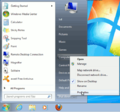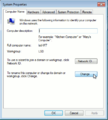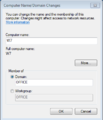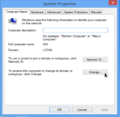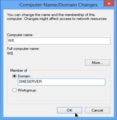|
|
| (27 intermediate revisions by 2 users not shown) |
| Line 1: |
Line 1: |
| − | [[User:Trex|Trex]] ([[User talk:Trex|talk]]) 13:32, 10 February 2013 (MST) Checked for errors, edits completed. | + | --[[User:Stephdl|Stephdl]] ([[User talk:Stephdl|talk]]) 04:08, 10 July 2013 (MDT) we should add more informations concerning W8 as it is the newer version of Microbug. I have to add some screenshots on the W8 workgroup and for the network setting of W8 if it differs really of W7 network setting. I have started these changes in the french translation of our manual chapter 7 |
| | | | |
| − | [[User:Trex|Trex]] ([[User talk:Trex|talk]]) 14:28, 10 February 2013 (MST) Change refs to Windows 95 and 98 to XP, Vista and Windows 7, will require a rework of procedures to match thos OS's - Is it warranted to do this, or just remove refs to 95 and 98 and the specifics of the OS.? | + | --[[User:Stephdl|Stephdl]] ([[User talk:Stephdl|talk]]) 03:39, 15 August 2013 (MDT) adding a note box at the end to inform about the windows account |
| | | | |
| − | [[User:Olddog11|relayer]] ([[User talk:Olddog11|talk]]) 14:36, 11 February 2013 (MST) I think it is a good idea so as not to make the documentation look outdated, we should be promoting the software as modern and current. Probably no need to include XP, Vista and Windows 7, if let's go for Windows 7 only.
| + | =====Connecting to a Domain===== |
| − | | + | See [http://wiki.contribs.org/Windows_8_Support Windows 8 Support] and [http://wiki.contribs.org/Windows_7_Support Windows 7 Support] for detailed version specific help. |
| − | {{WIP box|stephdl}} [[User:Stephdl|Stephdl]] ([[User talk:Stephdl|talk]]) 10:46, 16 February 2013 (MST)
| |
| − | | |
| − | [[User:Stephdl|Stephdl]] ([[User talk:Stephdl|talk]]) 15:58, 16 February 2013 (MST) the weight of picture is too low, about 50KB, it is not enought to have pretty picture i have raised a bug.
| |
| − | [[bugzilla: 7359]]
| |
| − | | |
| − | <noinclude>{{Languages}}</noinclude>
| |
| − | ===Configuring the Computers on Your Network=== | |
| − | | |
| − | ====What Order to do Things==== | |
| − | For efficiency, we recommend you configure your desktop computers in the following order:
| |
| − | | |
| − | Step 1: First, configure one of your desktop computers to work with TCP/IP (using the information in this chapter).
| |
| − | | |
| − | Step 2: With TCP/IP up and running on one of your computers, you can now access the server manager over the web and create your employees' user accounts. [[SME Server:Documentation:Administration Manual:Chapter8 | The next chapter]], explains this simple process.
| |
| − | | |
| − | Step 3: Once e-mail accounts are created, you can ensure that all the computers on your network are configured for TCP/IP, e-mail, web browsing and LDAP using the information in this chapter and the [[SME_Server:Documentation:User_Manual | User Manual]].
| |
| − | | |
| − | This chapter helps you configure software and hardware supplied by other companies and for that reason is not as specific as the rest of this guide. Given the wide range of computers, operating systems and software applications, we cannot accurately explain the process of configuring each of them. If your computers and applications came with manuals, they might be useful supplements to this chapter. Technical problems encountered in networking your desktop computers and applications are best resolved with the vendors who support them for you.
| |
| − | | |
| − | {{Warning box|This chapter demonstrates only one of the many possible ways to configure your client computers and is provided here as an example.}}
| |
| − | | |
| − | ====Configuring Your Desktop Operating System====
| |
| − | The dialog box where you configure your desktop differs from operating system to operating system and version to version. As an example, in Microsoft Windows Seven, client configuration occurs in the "Properties" dialog box associated with the TCP/IP protocol for your ethernet adapter. If a TCP/IP protocol is not yet associated with your ethernet adapter, you may need to add one before you can configure its properties with the following information.
| |
| − | | |
| − | {{tip box|To get there, go to the notification area at the bottom right, click on the icon network, select open "network and sharing center" then use the link "connection to the local network" and finally the Properties tab.}}
| |
| − | | |
| − | [[Image:W7-network-1.png]] | |
| − | | |
| − | [[Image:W7-2]]
| |
| − | | |
| − | [[Image:W7-network-3.png]]
| |
| − | | |
| − | {| border="1"
| |
| − | |+
| |
| − | ! Item !! Description !! What to enter
| |
| − | |-
| |
| − | ! enable TCP/IP protocol
| |
| − | | All your computers must communicate on the network using the TCP/IP protocol.
| |
| − | | In Windows you add a TCP/IP protocol. In Apple, open TCP/IP Control Panel.
| |
| − | |-
| |
| − | ! disable non-TCP/IP protocols
| |
| − | | Unless an application relies on a non- TCP/IP protocol, disable all other protocols.
| |
| − | | Turn "off" other networking protocols (e.g. NetBeui, etc.)
| |
| − | |-
| |
| − | ! enable DHCP service
| |
| − | | See section below
| |
| − | | In Windows, enable "Obtain an IP address service automatically". In Apple, select "DHCP server".
| |
| − | |}
| |
| − | | |
| − | {{Note box|We strongly recommend that you configure all clients machines using DHCP rather than manually using static IP addresses. Should you ever need to change network settings or troubleshoot your network later, you will find it much easier to work in an environment where addresses are automatically assigned.}}
| |
| − | | |
| − | On a Windows seven system, the window will look like the image below.
| |
| − | | |
| − | [[Image:Tcp_ip_properties_ip_auto.png]]
| |
| − | | |
| − | =====Automatic DHCP Service=====
| |
| − | Your server provides a DHCP server that assigns each of the computers on your network an IP address, subnet mask, gateway IP address and DNS IP address(es). For a more detailed explanation of DHCP, consult the section in the|Chapter 5 called "Configuring Your DHCP Server".
| |
| − | | |
| − | {{Note box|In some rare cases, you may want to use a static IP address for a particular client machine. The typical approach is to manually enter this IP address into the network properties of the specific machine. The negative side of this approach is that you cannot easily change or alter network settings without having to go in and modify the information on the client machine. However, it is possible to provide this static IP address directly through DHCP rather than manually configuring the client computer. To do so, you will first need to determine the Ethernet address of the client computer (usually through the network properties). Next you will go to the Hostnames and addresses web panel of the server manager and enter the information there.}}
| |
| − | | |
| − | {{Warning box|Only One DHCP Server
| |
| − | It is imperative that no other DHCP server is on your network. If a former DHCP server configured your computers, you should remove that DHCP server from your network. Leave DHCP enabled, and reboot each computer. New IP addresses, netmasks, gateway IP addresses and DNS addresses will be assigned automatically by the server DHCP server.}}
| |
| | | | |
| − | =====Manual entry for computers not using DHCP service=====
| + | *For Windows 7 |
| − | As noted above, we strongly recommend that you perform all your client configuration using DHCP. It is even possible to assign a static IP address through the Hostnames and addresses web panel of the server manager that will be distributed through your DHCP server.
| + | To connect a windows Seven client to your domain, Go to the "start menu", right click on computer, select "Properties", select the link "change Settings", then click on "Change" Tab.. Enter your servers "workgroup" value in the domain field and 'Connect'. Enter the username of admin(*) with the servers admin password when asked, and you should get back the response 'Connected to workgroup'. |
| − | However, if your computers do not support DHCP, you must manually enter the following information into your TCP/IP properties:
| |
| | | | |
| − | {| border="1"
| + | (*) Admin or any user in the 'Domain Admins' group can join the domain.<br /> |
| − | |+
| |
| − | ! Item !! Description !! What to enter
| |
| − | |-
| |
| − | ! IP address
| |
| − | | Manually enter this information (see paragraph below).
| |
| − | | You must assign a different, unique IP address to computers not accepting DHCP (see note below).
| |
| − | |-
| |
| − | ! subnet mask (or netmask)
| |
| − | | Manually enter this number.
| |
| − | | The default subnet mask (or netmask) is "255.255.255.0".
| |
| − | |-
| |
| − | ! gateway IP address
| |
| − | | Enter the IP address for the server or, in the case of server-only mode, enter the IP address for your network's gateway (e.g. the firewall or network router).
| |
| − | | If you are running in server and gateway mode, your server is your local network's gateway. Enter its IP address here: the default is "192.168.1.1". If you are running in server-only mode, enter the IP address for the device interfacing with your external network(i.e the box of your Internet Service Provider for example).
| |
| − | |-
| |
| − | ! IP addresses of your domain name servers
| |
| − | | Manually enter this information.
| |
| − | | Normally you would just add the IP address for your server - the default used in the server console is "192.168.1.1". If you have a firewall other than your server that restricts internal queries to Internet DNS servers, you may need to enter additional DNS servers here.
| |
| − | |}
| |
| | | | |
| − | It is critical that every computer on your network has a unique IP address and that you don't assign two computers the same address. In enabling DHCP service in the server console, you designated a range of IP addresses for DHCP assignment. You also allocated a block of IP addresses for manual assignment. If you accepted the defaults pre-configured into the server console, IP addresses 192.168.1.2 through 192.168.1.64 will have been set aside for manual entry. To avoid duplication, use only those IP addresses when manually assigning IP addresses to your computers.
| + | <gallery> |
| | + | Image:W7-4.png |
| | + | |
| | + | Image:W7-5.png |
| | | | |
| − | [[Image:Tcp_ip_properties_ip_select.png]]
| + | Image:W7-6.png |
| | | | |
| − | After configuring the TCP/IP parameters, you may need to reboot your desktop computer to implement the configuration changes. (For example, most Windows systems need to be rebooted after the TCP/IP configuration has been changed.) Once the settings take effect, your computer will be connected to the server and to the Internet.
| + | Image:W7-8.png |
| | + | </gallery> |
| | + | *For Windows 8 |
| | + | To connect a windows 8 client to your SME Server Domain, Go to the Top right corner of your Desktop, select "settings" and then "PC Info", select the link "change Settings", then click on "Change" Tab.. Enter your servers "Domain" value in the domain field and 'Connect'. Enter the username of admin(*) with the servers admin password when asked, and You should get back the response 'Connected to Domain'. Reboot the computer to reach the Domain.<br /> |
| | | | |
| − | =====MS Windows workgroup configuration=====
| + | (*) Admin or any user in the 'Domain Admins' group can join the domain.<br /> |
| − | If you are using a Microsoft operating system, you must ensure that your workgroup is the same as the workgroup name of your server. (In a subsequent chapter, we'll explain how this can be set using the web-based server manager.) Go to the Control Panel, select "System" --"Network"-- and "Computer Name" and click Change. In the field for "Workgroup", type your "workgroup".
| |
| | | | |
| − | =====MS Windows Domain configuration=====
| + | <gallery> |
| − | SME Server can be configured to be the "Workgroup and Domain Controller" for your network, here users do not need accounts on individual PC's but authenticate against the Server. (In a subsequent chapter, we'll explain how this can be set using the web-based server manager.)
| + | Image:W8-domain-1.png |
| − | | |
| − | =====Connecting to a Domain=====
| |
| − | To connect a windows Seven client to your domain, go to the "Control Panel", select "System", then "Computer Name", and click on change. Enter your servers "workgroup" value in the domain field and 'Connect'. Enter the username of admin(*) with the servers admin password when asked, and you should get back the response 'Connected to workgroup'.
| |
| | | | |
| − | (*) Admin or any user in the 'Domain Admins' group can join the domain.
| + | Image:W8-domain-2.png |
| | | | |
| − | =====Setting up network drives=====
| + | Image:W8-domain-3.png |
| − | If you are using SME Server as a domain controller and the workstations have joined the domain
| |
| − | you can automate drive mapping and syncronise the PC time with the netlogon.bat file
| |
| | | | |
| − | Note: [[:SME_Server:Documentation:Administration_Manual:Chapter13#Workgroup |Chapter 13]] has a method for admin to edit the netlogon.bat file without using the command line.
| + | Image:W8-domain-4.png |
| | | | |
| − | nano -w /home/e-smith/files/samba/netlogon/netlogon.bat
| + | Image:W8-domain-5.png |
| | | | |
| − | REM To set the time when clients logon to the domain:
| + | Image:W8-domain-6.png |
| − | net time \\servername /set /yes
| + | </gallery><br /> |
| − | REM To map a home directory to drive h:
| |
| − | net use h: /home /persistent:no
| |
| − | net use j: \\servername\ibay1 /persistent:no
| |
| − | net use p: \\servername\ibay2 /persistent:no
| |
| − | if exist Z: net use Z: /del /yes
| |
| | | | |
| − | and reset file to dos format
| + | {{note box|With Windows 8 there are now two types of account, a Microsoft account that allows you to have a single sign on all cloud services that Microsoft wants you to use, but does not allow you to authenticate to the domain services of the SME server. In fact if you want to use single sign on your Local network you need to turn your Microsoft account to a Local Account. This allows you to use cloud services informing you whenever it is necessary to give the Windows account password. See [[Windows_8_Support#Microsoft_Account_or_Local_account]]}} |
| − | unix2dos /home/e-smith/files/samba/netlogon/netlogon.bat
| |
--Stephdl (talk) 04:08, 10 July 2013 (MDT) we should add more informations concerning W8 as it is the newer version of Microbug. I have to add some screenshots on the W8 workgroup and for the network setting of W8 if it differs really of W7 network setting. I have started these changes in the french translation of our manual chapter 7
--Stephdl (talk) 03:39, 15 August 2013 (MDT) adding a note box at the end to inform about the windows account
Connecting to a Domain
See Windows 8 Support and Windows 7 Support for detailed version specific help.
To connect a windows Seven client to your domain, Go to the "start menu", right click on computer, select "Properties", select the link "change Settings", then click on "Change" Tab.. Enter your servers "workgroup" value in the domain field and 'Connect'. Enter the username of admin(*) with the servers admin password when asked, and you should get back the response 'Connected to workgroup'.
(*) Admin or any user in the 'Domain Admins' group can join the domain.
To connect a windows 8 client to your SME Server Domain, Go to the Top right corner of your Desktop, select "settings" and then "PC Info", select the link "change Settings", then click on "Change" Tab.. Enter your servers "Domain" value in the domain field and 'Connect'. Enter the username of admin(*) with the servers admin password when asked, and You should get back the response 'Connected to Domain'. Reboot the computer to reach the Domain.
(*) Admin or any user in the 'Domain Admins' group can join the domain.

|
Note:
|
|
|
With Windows 8 there are now two types of account, a Microsoft account that allows you to have a single sign on all cloud services that Microsoft wants you to use, but does not allow you to authenticate to the domain services of the SME server. In fact if you want to use single sign on your Local network you need to turn your Microsoft account to a Local Account. This allows you to use cloud services informing you whenever it is necessary to give the Windows account password. See Windows_8_Support#Microsoft_Account_or_Local_account
|
